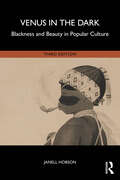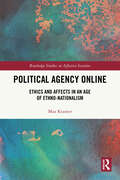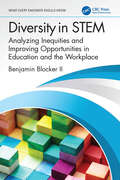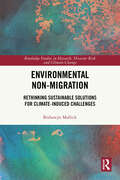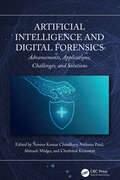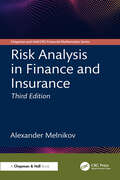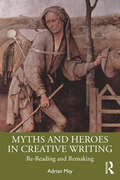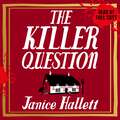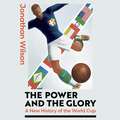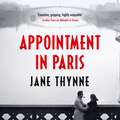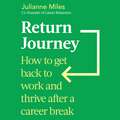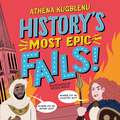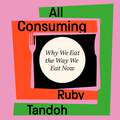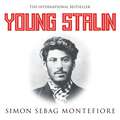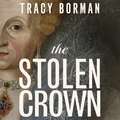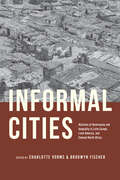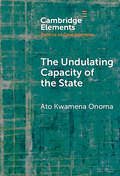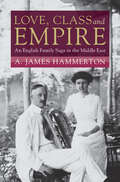- Table View
- List View
Venus in the Dark: Blackness and Beauty in Popular Culture
by Janell HobsonIn this third edition of the classic cultural history of black women’s beauty, Venus in the Dark: Blackness and Beauty in Popular Culture, Janell Hobson explores the enduring figure of the “Hottentot Venus” and the history of critical and artistic responses to her by black women in contemporary photography, film, literature, music, and dance.In 1810, Sara Baartman was taken from South Africa to Europe, where she was put on display at circuses, salons, museums, and universities as the “Hottentot Venus.” The subsequent legacy of representations of black women’s sexuality—from Josephine Baker to Serena Williams to hip-hop and dancehall videos, to our favorite pop acts including Beyoncé, Rihanna, and Megan Thee Stallion—refer back to her iconic image. Via a new Preface, Hobson explores the continuing influence of Baartman’s legacy through the contemporary marketization of black women’s bodies; from popular music and pornography to advertising and presidential campaigns. A brand-new chapter analyzes fetishistic spectacles of the black “booty,” with particular emphasis on the rise in cosmetic surgeries, such as BBLs, and the different ways that twenty-first-century subjects have reshaped and redefined their bodies in an emergent global body politic.This new edition of Venus in the Dark: Blackness and Beauty in Popular Culture is essential reading for students and researchers, as well those outside of academia interested in the subjects of black women and their beautification efforts.
The Art of Making Decisions Under Uncertainty
by Charles YoeUncertainty is a part of every decision we make, from the everyday to the high-stakes, from personal choices to professional strategy. The Art of Making Decisions Under Uncertainty offers a clear, practical approach to dealing with the unknown without getting stuck or overwhelmed.Rather than treating uncertainty as a barrier, this book invites readers to see it as a constant companion—something to work with, not work against. Drawing on proven tools, real-world examples, and a wealth of practical insight, it shows how to make thoughtful, informed decisions even when information is incomplete, priorities are competing, and the path forward feels anything but clear.This is not a theory-heavy treatise. It’s a textbook guide for real people facing real decisions. Grounded in decision science but written for a broad audience, it bridges the gap between technical complexity and everyday practicality. Whether you’re leading a team, managing risk, shaping policy, or simply trying to make better personal choices, this book meets you where you are—with tools that work, language that makes sense, and encouragement to move forward with clarity and confidence.Inside you’ll find: Straightforward frameworks to help you recognize and manage different types of uncertainty Practical tools and techniques you can use right away to make sound decisions in fast-moving or high-pressure situations Case studies and examples that bring the concepts to life and show how they apply in work, leadership, and daily life Fresh perspectives on failure, bias, and risk, helping you not only avoid common pitfalls but turn setbacks into sources of insight If you’ve ever hesitated at a crossroads, second-guessed a big decision, or wished for more clarity in a world that rarely offers it, this book is for you. The Art of Making Decisions Under Uncertainty is your companion in making better choices when certainty is out of reach but a good decision is still within your grasp.
Political Agency Online: Ethics and Affects in an Age of Ethno-Nationalism (Routledge Studies in Affective Societies)
by Max KramerThis book examines the ways that political agency can be understood in digitally dominated media environments. Kramer shows how emotional work on the online-active self is both culturally and institutionally embedded. Filling a gap in the scholarship on the affective conditions of agency, this book conceptualizes political agency online through case studies that center on the creativity of—and difficulties faced by—Indian Muslims who run popular handles on social networking sites. The book will appeal to scholars and students interested in affect and emotion, digital and political ethics, media anthropology, South Asian studies, mediation and Muslim politics in India.
Diversity in STEM: Analyzing Inequities and Improving Opportunities in Education and the Workplace (What Every Engineer Should Know)
by Benjamin Blocker IIDiversity in STEM: Analyzing Inequities and Improving Opportunities in Education and the Workplace offers a survey of diversity in the broad field of Science, Technology, Engineering, and Mathematics (STEM) and provides potential solutions to improve outcomes in education, industry, and society. Offering a U.S.-based point of view, but with globally applicable concepts around race, gender, culture, politics, and socioeconomics, the book identifies where issues around diversity in STEM exist, how they were created, and how these issues are being addressed in STEM education and the STEM workforce.Features: Identifies conditions and causes of inequities from a societal perspective. Offers guidelines and solutions to identify and address cultural gaps in STEM. Covers STEM initiatives implemented at the K-12, college, and vocational levels and how they are beginning to alter the STEM landscape. Illustrates the benefits of fostering and maintaining a diverse, equitable, and inclusive workforce. Explores best practices used by companies and organizations to recruit, support, and develop diverse talent and strategies to continually evolve. Guides and empowers STEM professionals to seek out organizations whose values are aligned with their own. Providing an analytical and constructively practical viewpoint, the authors offer readers across the sciences, engineering, and medicine, as well as policymakers, the opportunity to consider why diversity and equity in STEM matter and how to apply best practices that support inclusivity to ensure successful outcomes for individuals, organizations, and society.
Environmental Non-Migration: Rethinking Sustainable Solutions for Climate-Induced Challenges (Routledge Studies in Hazards, Disaster Risk and Climate Change)
by Bishawjit MallickThis book challenges the dominant narrative of migration as the default response to climate change, introducing the concept of Environmental Non-Migration (ENM).It provides insights into why communities choose to remain in specific locations despite environmental risks and how staying can be an active adaptation strategy. It integrates theoretical frameworks, historical contexts, and global case studies, highlighting cognitive, cultural, and socio-economic influences on mobility decisions. By offering policy recommendations and real-world examples, the book equips researchers and policymakers with a new perspective on climate adaptation, fostering resilience, community empowerment, and sustainable development while preserving cultural heritage and strengthening local adaptation efforts.This book will be of interest to researchers, policymakers, and practitioners interested in climate adaptation, environmental studies, migration studies, development, urban planning, and those who are exploring resilience strategies, community-based adaptation, sustainability, and socio-environmental decision-making.
Artificial Intelligence and Digital Forensics: Advancements, Applications, Challenges, and Solutions
by Archana Patel Naveen Kumar Chaudhary Abinash Mishra Chothmal KumawatArtificial Intelligence (AI) has revolutionized several sectors, with digital forensics being one that has been notably affected by its rapid advancement. AI brings previously unheard-of powers to this field, helping authorities examine large datasets, identify developments, and uncover digital evidence that is essential to cracking cybercrimes. Despite these promising developments, using AI in digital forensics presents problems. The complexity and dynamic nature of cyber-attacks are a significant challenge, demanding the ongoing adaptation of AI models to new attack strategies. This changing environment makes it difficult to create reliable and future-proof solutions. This book explores the advancements, applications, challenges, and solutions that AI brings to the realm of digital forensics.Artificial Intelligence and Digital Forensics: Advancements, Applications, Challenges, and Solutions includes the latest applications and examples with real data making the book meaningful for readers. It is written in very simple language with each technology having its dedicated chapter that explains how it works and provides an example of a real-world application. Key points and a summary are provided at the end of each chapter to enable the readers to quickly review the major concepts as it presents a practical understanding, so the readers can be better equipped to handle AI-based tools with ease and efficiency. The book provides unconditional support to those who are making decisions by using massive data from their organization and applying the findings to real-world current business scenarios addressing the challenges associated with integrating AI into digital forensics and offering practical solutions. It also offers insights into the ethical use of AI technologies and guidance on navigating legal requirements and ensuring responsible and compliant practices.This book caters to industry professionals from diverse backgrounds, including engineering, data science, computer science, law enforcement, and legal experts, fostering a holistic understanding of the subject along with providing practical insights and real-world examples.
Risk Analysis in Finance and Insurance (Chapman and Hall/CRC Financial Mathematics Series)
by Alexander MelnikovRisk Analysis in Finance and Insurance, Third Edition presents an accessible yet comprehensive introduction to the main concepts and methods that transform risk management into a quantitative science. Considering the interdisciplinary nature of risk analysis, the author discusses many important ideas from stochastic analysis, mathematical finance and actuarial science in a simplified manner. He explores the interconnections among these disciplines and encourages readers toward further study of the subject. This edition continues to study risks associated with financial and insurance contracts, using an approach that estimates the value of future payments based on current financial, insurance, and other information.Features of the third edition 12 chapters instead of 8 of the 2nd editions. Two new chapters on Wiener process as a base for financial market modeling. Option pricing in the Bachelier model, the model of Black and Scholes, the Gram-Charlier model. American options and their pricing in the Black-Scholes model Several new notions, topics and results that are not reflected yet in other textbooks, and even in monographs (Binomial model with constraints, detailed exposition of quantile hedging technique, Conditional Value at Risk, Range of Value at Risk, applications to equity-linked life insurance) Can be regarded as a self-contained issue of courses on Mathematical Finance, Actuarial Science and Risk Management Replete with new exercises, problems, hints and solutions
Myths and Heroes in Creative Writing: Re-Reading and Remaking
by Adrian MayMyths and Heroes in Creative Writing: Re-Reading and Remaking offers a comprehensive overview of myth throughout history. Exploring a variety of forms, Adrian May provides a framework for the practice and process of writing myths.This accessible guide discusses a rich and diverse range of literary examples across myth, theatre, poetry and criticism to make a clear and compelling case for a reimagining of the epic and heroic. It celebrates the depth and subtlety of myth and its ability to overcome clichés, while offering essential advice on plotting, editing and retelling classical myths. It features practical advice and exercises for a complete writing experience.Inspiring creativity and advancing comprehension, this book is for anyone interested in the creative use of myth. This includes writers, artists and all who seek to see beyond the surface of things and gain new insights into mythology.
The Killer Question
by Janice Hallett* THE NEW FIENDISHLY CLEVER MYSTERY FROM THE AUTHOR OF THE SMASH-HIT BESTSELLER THE APPEAL *'Brims with Hallett's signature wit. Her best book yet' - PETER SWANSON'Devilishly additive. I loved every line' - LOUISE CANDLISH'The modern Queen of Crime does it again' - IAN MOOREThe answer is murder.The question is whodunnit?A quiet country pub stands empty, its windows boarded up. And its kindly landlords,Mal and Sue Eastwood, are missing.What could have happened? A lot of strange events occurred in the days before theEastwoods disappeared. A murdered man pulled from the nearby river. An eccentriccouple on a houseboat who claimed to be led by a spirit guide. And a mysterious newteam who suddenly appeared and began winning every round at the weekly pub quiz -much to the anger of the locals. They must have been cheating, but no one could figureout how...Can you crack the case of the missing landlords? Someone's not been playing fair, soget the drinks in and see if you can get a perfect score.'Another brilliant, twisty mystery from Janice Hallett' - ELLY GRIFFITHS'So clever and entertaining' - JENNIE GODFREY'You'll never look at pub quizzes the same way again' - VASEEN KHAN
The Power and the Glory: A New History of the World Cup
by Jonathan Wilson'A master at telling football's greatest ever stories... Breathtaking. Wilson's eye for detail and his elegant writing brings the World Cup to life like no other book on the topic I have ever read' ELIS JAMES'Epic in scope, awesomely rich in detail, and compulsively entertaining' TOM HOLLAND'So much of what we know of football's history we know thanks to Wilson' SIMON KUPERThe football World Cup is the most watched sporting event on the planet. It has become a global obsession: 211 nations initially entered the 2022 edition. It has been running for almost a century. Yet there is no comprehensive history of the tournament: based on fresh interviews and meticulously researched this book will change that. By 1930, football had outgrown the Olympic Games. A new competition, run by Fifa, would take international football to the next level. After a shambolic start to the first cup in Uruguay - an incomplete stadium, shoddy refereeing and physios accidentally injuring players - the thrilling final saw Uruguay take on Argentina, beating them 4-2. From those chaotic beginnings grew the modern World Cup, a cultural phenomenon that draws the world together like nothing else, and that gives it a profound importance. Ask a random person on a random street to name a moment in the history of Senegal and they may well say Pape Bouba Diop's winner against France in the 2002 World Cup, a goal not only against the defending champions but against the former colonial masters.The World Cup has political significance. West Germany's success in 1954 was a moment of reintegration into global society. Progress to the semi-finals in 1998 gave a huge boost to Croatia's sense of national self. But football is an unpredictable sport. In the so-called Soccer War of 1969 tensions between El Salvador and Honduras were ignited by a World Cup qualifier. More recently, the focus for governments seeking to political gain has been hosting the tournament, with the World Cups in Russia and Qatar clear examples of sportswashing, staging a tournament to project an image of a thriving society.There has never been a comprehensive history of the World Cup that has considered not only the matches and goals, the players and coaches, the tales of scandal and genius, the haggling and skulduggery of the bidding process, but has also placed the tournaments within a socio-political framework. The story of the World Cup is also the story of the world; this book tells its definitive history.
Appointment in Paris
by Jane ThynneONE OF THE TIMES BEST HISTORICAL FICTION BOOKS OF 2025'Blends a wholly convincing evocation of the period with a compelling narrative' The Times'After their riveting debut in Vienna, Fox and Fry are back in compelling fashion to navigate their way through a shadowy world of espionage and murder. Danger and secrecy lurk in every page of this classy novel' ALEX GERLIS, author of EVERY SPY A TRAITOR'Suspenseful, romantic, atmospheric and clever . . . Thynne's storytelling is hugely enjoyable escapism' AMANDA CRAIG, author of THE THREE GRACES'Deeply researched but lightly told, this book had me on the edge of my seat. Absolutely cracking stuff' CLARE MULLEY, author of AGENT ZOFollowing an acclaimed debut outing, Harry Fox, an MI5 Watcher, now suspended, and his associate Stella Fry are reunited during Britain's darkest hour in this gripping espionage thriller.April 1940, and Britain is in turmoil. Chamberlain's government is faltering, and a German invasion may be only weeks away.A body, wearing the uniform of a Luftwaffe captain, is found in the grounds of Trent Park - a stately home and now a prison to house high level German POWs. Trent Park's true purpose, however, is intelligence, gathered covertly from prisoners by secret listeners.The morning after the discovery of the body, one of the listeners goes missing, along with a gun from the firing range. Horrified that this could blow the highly confidential operation wide open, the missing man must be tracked down.Cue Harry Fox, a former MI5 Watcher, now suspended. He is desperate to assist the war effort but he's over the conscription age. Then his former boss gets in touch with a job for him, to track down the missing man. But, he stipulates, it must also involve Harry's former associate, Stella Fry.Stella returns home from work in the blackout to find a crowd outside her flat. She is told that a young woman in the building has had a fatal accident. The dead woman is called Stella Fry. Outraged, Stella suspects that this is the work of her erstwhile friend, Harry Fox. But why on earth would he go to such lengths to contact her?
Return Journey: How to get back to work and thrive after a career break
by Julianne MilesA highly useful, inspiring guide for anyone returning to work after a career break, by a world-renowned return to work expert and Chartered Psychologist.'A must read for anyone who wants to return to work.' SARAH ELLIS, co-founder of Squiggly Careers'Accessible, informative and full of sound advice .' JANE GARVEY___________________________________________________Returning to work after a career break - for childcare, eldercare, for health or other reasons - can feel daunting and overwhelming. You don't have to find your way back alone.In Return Journey, Julianne Miles - a world-renowned return-to-work expert, Chartered Psychologist, and a successful returner herself - offers a psychology-led, step-by-step guide for any professional looking to get back to fulfilling work. Using a mix of practical advice, coaching exercises and real-life case studies, Return Journey will be your wise companion at every stage: from boosting your confidence as you start out, to offering advice on an effective job search strategy, to helping prepare you emotionally and practically for the first months back.Above all, Julianne proposes that returning to work is not about hiding your career break or struggling to catch up. It's about properly valuing your wealth of skills and experience, taking control of your story, and coming back stronger than ever before.
History's Most Epic Fails: Discover the truth behind the world’s biggest historical howlers (History's Most Epic)
by Athena KugblenuDiscover the truth behind the world's biggest historical howlers!History is full of daring deeds, mighty heroes and incredible inventions. But it's also full of humongous FAILS! Athena Kugblenu - comedian and writer on CBBC's Horrible Histories - explores them all, whether it be the silly mishaps that changed the course of history or the mistakes that did us all a favour.From the Titanic lookout who forgot his binoculars or the astronaut who taped over the Moon landings, to the famous inventors who failed THOUSANDS of times before getting something right, the amazing scientists who ACCIDENTALLY invented life-saving medicines and the businesses that went bust and bounced back better - take a riotous ride through history and discover the epic fails that changed the world.
Into the Dream Lab: The New Science of Dreams and Nightmares
by Michelle CarrThe science of dreams and nightmares - and their astonishing impact on our waking lives.Dreams slip away when we wake, their remnants jumbled and only half-recalled. Some leave behind surreal sensations or bursts of creativity. Others leave us shaken. But why do we dream at all? How do our bodies interface with our brains while we sleep? Why do some dreams go bad? And how can we harness our sleeping minds to improve our waking lives?Pioneering researcher in sleep medicine Dr Michelle Carr unlocks the science behind the sleeping body. Drawing on her expertise in nightmares, lucid dreaming and the cutting-edge field of dream engineering, she reveals how we can revolutionise our sleeping - and waking - health.Includes an exclusive bonus section with practical techniques for lucid dreaming, nightmare resolution, and dream engineering.
All Consuming: Why We Eat The Way We Eat Now
by Ruby Tandoh'A fascinating, sometimes shocking, eye-opener that is also brilliantly funny' CLAUDIA RODEN'Brilliant. I couldn't put it down' RUKMINI IYER'Completely dazzling' JIMI FAMUREWA'Endlessly inspirational' NIGEL SLATERThe iconic New Yorker and Vittles food writer asks: Why do we eat the way we eat now?Being into food - following and making it, queuing for it and discussing it - is no longer a subculture. It's become mass culture.The food landscape is more expansive and dizzying by the day. Recipes, once passed from hand to hand, now flood newspaper supplements and social media. Our tastes are engineered in food factories, hacked by supermarkets and influenced by Instagram reels.Ruby Tandoh's startlingly original analysis traces this extraordinary transformation over the past seventy-five years, making sense of this electrifying new era by examining the social, economic, and technologicalforces shaping the foods we hunger for today.Exploring the evolution of the cookbook and light-speed growth of bubble tea, the advent of TikTok critics and absurdities of the perfect dinner party, Tandoh's laser-sharp investigation leaves her questioning: how much are our tastes, in fact, our own?Discover All Consuming Bubble Tea | Critics | Recipes | Martha Stewart | Mob | Fast food | Hype queues | Nara Smith | Tiktok | Viennetta | Weekend supplements | Wife Guys | Cookbooks | Lobster | Influencers | Wellness elixirs| Entertaining | Keith Lee | Wimpy with Ruby Tandoh this autumn.
Young Stalin
by Simon Sebag MontefioreWinner of the Costa Biography AwardWhat makes a Stalin? Was he a Tsarist agent or Lenin's bandit? Was he to blame for his wife's death? When did the killing start? Based on revelatory research, here is the thrilling story of how a charismatic cobbler's son became a student priest, romantic poet, prolific lover, gangster mastermind and murderous revolutionary. Culminating in the 1917 revolution, Simon Sebag Montefiore's bestselling biography radically alters our understanding of the gifted politician and fanatical Marxist who shaped the Soviet empire in his own brutal image. This is the story of how Stalin became Stalin.
Paved with Good Intentions: A War for the Rose Throne novel (War for the Rose Throne #5)
by Peter McLeanEline is a mother, a wife, and a survivor. But her life is about to change dramatically. Following an act of horrific - if righteous - vengeance, Eline is blackmailed into the service of the Queen's Men. She knows it will be a hard life of violence and fear. But Eline will do what it takes to survive, and to protect her children . . . and if she's lucky, she won't die in the process.But the Queen's Men aren't just asking her to risk herself. They're asking her to risk everything she knows and loves. And if she fails . . . civil war and the deaths of everyone she loves will be just the beginning.A stand-alone novel set in the world of the War for the Rose Throne, perfect for fans of Joe Abercrombie and Alex Marshall, featuring an incredible and unforgettable female anti-hero.
The Stolen Crown: Treachery, Deceit and the Death of the Tudor Dynasty
by Tracy BormanThe explosive account of the succession of Elizabeth I from bestselling author Tracy Borman, Chief Historian at Historic Royal Palaces 'COMPELLING AND BRILLIANT' - ALISON WEIR'Reads like a political thriller' - GARETH RUSSELL, author of Queen James'Part political thriller . . . A thrilling achievement' - KATE WILLIAMS, author of Rival Queens'Wonderful . . . like a political thriller' - ELIZABETH NORTON, author of The Lives of Tudor Women----------In March 1603, Queen Elizabeth I, the last Tudor monarch, lies dying at Richmond Palace. The queen's ministers cluster round her bedside, urging her to name her successor - something she has stubbornly resisted throughout her reign. Almost with her last breath she whispers that James VI of Scotland should succeed her.Or so we've been led to believe.But, as enthralling new research shows, this is not what happened. Elizabeth went to her grave without formally naming an heir. The notion of an approved succession from Tudors to Stuarts is little more than an elaborately constructed fiction - a fiction that went on to have devastating consequences. The Stuart regime rapidly descended into turbulence and uncertainty, conspiracy and persecution, witchcraft and gunpowder.With a combination of rigorous research and brilliant storytelling, The Stolen Crown takes us behind palace doors to reveal the secret history of the Tudor succession.
Informal Cities: Histories of Governance and Inequality in Latin Europe, Latin America, and Colonial North Africa
by Brodwyn Fischer Charlotte VormsAn empirically rich reconstruction of how informality became an intrinsic part of urban life across three continents. Over a quarter of the world’s urban population lives in informal settlements. While informality as a concept has been widely debated, we still know very little about the phenomenon’s urban history or how that history has shaped the evolution of world cities. Spotlighting the historical processes that have created and sustained urban informality for more than a century, editors Charlotte Vorms and Brodwyn Fischer and this volume’s contributors reveal informality as an intrinsic feature of urbanity, shaping not only cities across the globe but also deeper processes of state formation, socioeconomic stratification, and political struggle. The volume brings together case studies spanning more than a hundred years, drawn from Latin America (Brazil, Chile, Venezuela, and Mexico), Northern Africa (Morocco and Algeria), and Latin Europe (France, Spain, and Italy). Together, they show that informality is neither a contemporary crisis nor a predicament unique to the Global South. Topics include the origins of informal settlements and their relationship with law and institutional power; grassroots efforts to legitimize shantytown communities; mass social movements for rights to the city; the role that shantytown removal campaigns played in populist politics, fascism, and colonialism; and the ways that informality perpetuated racial and ethnic inequalities. Informal Cities is an indispensable guide to the complex and fraught terrain of urban informality in its many historical guises.
Unrefined: How Capitalism Reinvented Sugar (Synthesis)
by David SingermanA surprising look at how modern capitalism changed sugar from a natural food to a scientific commodity. Sugar is everywhere in the western diet, blamed for epidemics of obesity, diabetes, and other modern maladies. Our addiction to sweetness has a long and unsavory history. Over the past five hundred years, sugar has shaped empires, made fortunes for a few, and brought misery for millions of workers both enslaved and free. How did sugar become a defining modern food and an essential global commodity? In Unrefined, David Singerman recasts our thinking about this crucial substance in the history of capitalism. Before the nineteenth century, sugar’s value depended on natural qualities: its color, its taste, where it was grown, and who had made it. But beginning around 1850, a combination of plantation owners, industrialists, and scientists set out to redefine sugar itself. Deploying the tools and rhetoric of science, they transformed not just how sugar was produced or traded but even how people thought about it. By changing sugar into a pure chemical object, these forces stripped power from workers and enabled—and obscured—new kinds of fraud, corruption, and monopoly. Taking us to unexplored spaces in the world of sugar, from laboratories and docks to refineries and the halls of Congress, Singerman illuminates dark intersections of the histories of corruption, science, and capitalism.
The Undulating Capacity of the State: Autochthony and Infrastructure Development in African Cities (Elements in the Politics of Development)
by Ato Kwamena OnomaThis Element weaves together literatures on autochthony and belonging and on African urbanism to shed new light on the ability of the African state to undertake development interventions in some of the most important urban centers on the continent. It explains variations in levels of trust in the African state that shape neighborhoods' responses to states' development interventions. Focusing on the Senegalese state's construction of the VDN 2 highway on the outskirts of the capital, Dakar, the author argues that in major African cities with colonial origins, whether neighborhoods project themselves as 'autochthonous' or 'migrant' communities shapes general attitudes toward the state and influences the capacity of the state to carry out development interventions in these areas. In these cities, states are more likely to successfully intervene in neighborhoods dominated by 'new' migrants to the city than in those neighborhoods that portray themselves as 'autochthones' of these cities.
Human Cognitive Diversity (Elements in the Philosophy of Biology)
by Ingo BrigandtWe humans are diverse. But how to understand human diversity in the case of cognitive diversity? This Element discusses how to properly investigate human behavioural and cognitive diversity, how to scientifically represent, and how to explain cognitive diversity. Since there are various methodological approaches and explanatory agendas across the cognitive and behavioural sciences, which can be more or less useful for understanding human diversity, a critical analysis is needed. And as the controversial study of sex and gender differences in cognition illustrates, the scientific representations and explanations put forward matter to society and impact public policy, including policies on mental health. But how to square the vision of human cognitive diversity with the assumption that we all share one human nature? Is cognitive diversity something to be positively valued? The author engages with these questions in connection with the issues of neurodiversity, cognitive disability, and essentialist construals of human nature.
World Englishes as Components of a Complex Dynamic System (Elements in World Englishes)
by Edgar W. SchneiderThis Element proposes to view World Englishes as components of an overarching Complex Dynamic System of Englishes, against the conventional view of regarding them as discrete, rule-governed, categorial systems. After outlining this basic idea and setting it off from mainstream linguistic theories, it introduces the theory of Complex Dynamic Systems and the main properties of such systems (systemness, complexity, perpetual dynamics, network relationships, the interplay of order and chaos, emergentism and self-organization, nonlinearity and fractals, and attractors), and surveys earlier applications to language. Usage-based linguistics and construction grammar are outlined as suitable frameworks to explain how the Complex Systems principles manifest themselves in linguistic reality. Many structural properties and examples from several World Englishes are presented to illustrate the manifestations of Complex Systems principles in specific features of World Englishes. Finally, the option of employing the NetLogo programming environment to simulate variety emergence via agent-based modeling is suggested.
Anton Webern at the Dawn of Modernism (Music in Context)
by Sebastian WedlerAnton Webern is recognised as one of the pivotal figures of atonality and precursors to post-war serialism. However, his earlier, tonal works have been largely neglected and shrouded in clichés. A study of both the generative elements of Webern's aesthetic imagination, and the philosophical signatures of musical modernity, this first book-length account of Webern's tonal music explores the complex and variegated ways in which the young composer engaged with, and sought to contribute to, the cultural discourses of fin-de-siècle modernism, well before he self-consciously embarked upon his famous 'path' to the New Music. While acknowledging the rapid stylistic transformation that Webern's musical language underwent, the author suggests that earliness in Webern is not simply a chronological term but is rather best understood in terms of a constitutive tension between phenomenological and dialectical modes of musical thought.
Love, Class and Empire: An English Family Saga in the Middle East (Modern British Histories)
by A. James HammertonEarly twentieth-century Persia and the Persian Gulf presented a largely blank slate to the British, best known only as a vital conduit to India and a site of contest – the 'great game' – with the Russian Empire. As oil discoveries and increasing trade brought new attention, the expanding telegraph and river shipping industries attracted resourceful men into junior positions in remote outposts. Love, Class and Empire explores the experiences of two of these men and their families. Drawing on a wealth of personal letters and diaries, A. James Hammerton examines the complexities of expatriate life in Iran and Iraq, in particular the impact of rapid social mobility on ordinary Britons and their families in the late imperial era. Uniquely, the study blends histories of empire with histories of marriage and family, closely exploring the nature of expatriate love and sexuality. In the process, Hammerton discloses a tender expatriate love story and offers a moving account of transient life in a corner of the informal empire.
